音节划分举例讲课教案
英语 如何划分音节 教案

英语如何划分音节教案一、教学目标1. 知识目标:学生能够理解音节的概念,掌握英语中划分音节的规则。
2. 能力目标:学生能够正确划分单词中的音节,并正确拼读单词。
3. 情感目标:培养学生对英语学习的兴趣,激发他们学习的积极性。
二、教学重点与难点1. 重点:英语中音节的划分规则及应用。
2. 难点:一些特殊情况下的音节划分问题。
三、教学准备1. 教材:课本、音频资料。
2. 工具:投影仪、黑板、笔等。
3. 教具:图片、单词卡片等。
四、教学过程1. 导入:通过图片、视频等形式引入问题,让学生猜测何为音节,引发学生思考。
2. 提出问题:教师向学生提出划分音节的重要性,激发学生对本课内容的兴趣。
3. 授课:介绍音节的概念及划分规则,通过例子加深学生对音节的理解。
4. 练习:教师出示单词卡片,让学生划分音节并读出单词,纠正学生错误的地方。
5. 拓展:带领学生发现单词中的特殊音节,并解释其划分规则。
6. 巩固:进行游戏活动或小组讨论,锻炼学生划分音节的能力。
7. 作业布置:要求学生完成相关练习,巩固所学知识。
五、教学反思通过对教学过程的分析和总结,发现学生在音节划分方面的常见错误,并制定相应的课堂活动进行纠正。
六、板书设计【音节的划分规则】1. 规则一:元音字母构成一个音节。
2. 规则二:辅音字母构成一个音节。
3. 规则三:两个及以上辅音字母在一起时,只有第一个辅音构成音节。
七、课后反馳及时对学生作业进行批改,发现问题及时纠正,并鼓励学生在日常生活中多加练习,提高划分音节的准确度和快速性。
划分音节 ppt课件
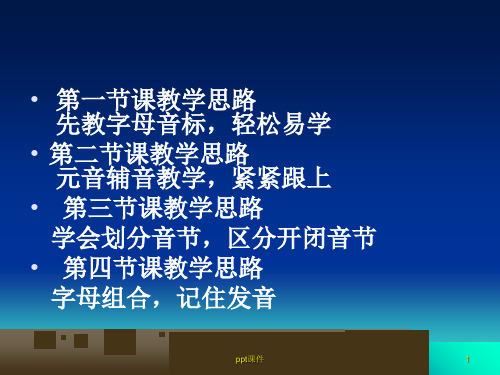
ppt课件
33
• 15页判断每组单词画线部分发音是否相同。 相同的画“√”,不同的画“×”
• ( ) 1.fat cat ( )2, thin ice • ( ) 3..here where ( )4. twin like • ( )5. same cat ( )6. year ears • ( )7. go come ( ) 8. happle bag
5
26个字母读音
Ff [ef] Ll [el] Mm[em] Nn [en]
Ss [es] Xx[eks] Zz[zed]
ppt课件
6
26个字母读音
Ii [ai] Yy [wai]
ppt课件
7
26个字母读音
Aa Bb Cc Dd Ee Ff Gg
[e i] [bi:] [s i:] [di:] [i:] [ef] [dʒi:]
name these bike rose
闭音节是指以辅音字母(除r和字母组合外) clock big
结尾的音节
desk
元音字母与辅音字母r结合,构成的音节
horse star first
元音字母与re结合,构成的音节 在单词中读的比较弱pp或t课件模糊的音节
care here Store
today a2f2ter
闭音节 [Λ]
bus cup must much mug cut us number
ppt课件
28
HOMEWORK
• 学会划分音节。掌握元音字母在单词中的 发音。
ppt课件
29
• 第一页 • 挑出含有不同元素的字母 • ( )1.A . Aa B. Dd C. Hh • ( ) 2.A. Ff B. Ee C..Bb • ( ) 3.A. Gg B. Jj C. Aa • ( ) 4.A. Ii B. Bb C. Ee
音节和音节的划分教学(课件)

开闭音节歌
开音节,音节开 不怕一副堵后门 a e I o u 就读 闭音节音节闭 辅音字母堵后门 a e I o u 要读 一元字母在后排 还有哑音e在门外 [ei] [i:] [ai] [3u] [ju:] 一元字母生闷气 一元字母音短急 [æ ] [e] [i] [ɔ] [∧]
音节的划分
1.一个单音节词从来不被划分音节.例:bus 2.当一个单词是复合单词时,在两个单词之间划分 音节.例:football 3.有前缀,后缀时,在前缀的后面:unhappy 在 后缀的前面:kindness 4.单词中有双写的辅音字母时,在两个辅音字母之 间划分音节.例:hap-py 5.在一个单词中,2个元音字母之间有2个或者更 多个的辅音字母时,通常在前2个辅音字母之间划分 音节,在第一个辅音之后划分. 例:an-gry,pic-ture
什么是音节?
一、音节:音节是读音的基本单位,任何单词的读音, 都是分解为一个个音节朗读。 在英语中元音特别响亮,一个元音可构成一个音节, 一个元音和一个或几个辅音音素结合也可以构成一个音节。 一般说来,元音可以构成音节,辅音不响亮,不能构成音节。 但英语辅音字母中有 4 个辅音[m],[n],[ng],[l]是响音, 它们和辅音音素结合,也可构成音节。 它们构成的音节往往出现在词尾,一般是非重读音节。 英语的词有一个音节的,两个音节的,多个音节的, 一个音节叫单音节,两个音节叫双音节,三个音节以上叫多 音节。 如:take 拿,ta'ble 桌子, po’pu’la'tion 人口, con’gra’tu’la'tion 祝贺。
音节的分类
1)音节按读音可以分为开音节和闭音节
开音节又可以分为绝对开音节和相对开音节 (1) 绝对开音节:是指一个元音字母后面没有 辅音字母而构成的音节,例如:we, hi, yo-yo (2) 相对开音节:是指一个元音字母后面有一个 辅音字母(除r)之外,最后是一个不发音的e构成的音节,如:take, make 在开音节中,这个元音字母发“字母”本身音, 例如hi|hai|, use|ju:z| (3) 闭音节:指元音字母后面有辅音字母(辅音字母r除外) 构成的音节,如:leg, cross 2)音节按重读可以分为重读音节和非重读音节 重读音节: 指在双音节或多音节词中有一个发音 特别响亮的音节,叫重读音节,用重音符号“`”标于 相应位置,其他音节为非重读音节,如begin |be’gin|, 单音节词作重读处理,但不标重音符号。
英语语音知识音节划分篇公开课一等奖市赛课获奖课件

2.次重音:在单词旳音标中,假如在某个音 标前旳下方见到 “ ‚ ” 这个符号,如 decode [‚diː‘kəʊd] , 这就是次 重音符号。这
个符号指旳是从其后旳音节开始全部使用
升调(接近汉语拼音第一声),直到遇到重
音符号才开始降调 ( 接近汉语拼音第四声 )
number →num/ber ['nʌmbə] → ['nʌm/bə]
3.多种中间偏左右:当两个元音字母中间, 有三个以上旳辅音字幕时,中间旳辅音 字母要么划分给前面旳音节当尾,要么 划分给背面旳音节当头。
E.g.
improve →im/prove [ɪm'pruːv] →[ɪm/'pruːv]
3.爆破音背面紧跟鼻音[m]、[n]或舌边音[1] 时,也会形成不完全爆破。例如:
good morning [gʊd ‘mɔːnɪŋ] m失去爆破
(三)特殊音标旳发音 1. 1. /m/、/n/、/l/这三个辅音音标,若其后
无元音音标,则发常规音。若其后有元音 音标,则发特殊音。
2. 2. /w/、/j/:若在其前有辅音音标,其后有 元音音标,则发音顺序为先后再前。用公 式体现为:辅+ /w/或/j/+元,先/w/或/j/+元 发音,然后再与前面旳辅音结合。如: [‘friːkwənt]、 [kjuːt]
如:
examination
[ɪg,zæmɪ’neɪ
congratulations [kən,grætjʊ‘leɪʃ(ə)ns]。
(二)不完全爆破音 1. 英语音标中,辅音[p]、[b]、[t]、[d]、 [k]、[g]是爆破音。当一种爆破音旳背面 紧跟着另一种爆破音时,前一种爆破音只 按其发音部位做好发音口形、形成阻碍, 而不爆破出来,稍微停止后即发出背面旳 辅音,这种现象称为不完全爆破,即有嘴 型,不发音。例如:
幼儿园教案:区分单音节和双音节词

幼儿园教案:区分单音节和双音节词本文旨在为幼儿园教师提供一份详细的教案,教授幼儿如何区分单音节和双音节词。
这个课程不仅是英语教学的重要基础,同时也是幼儿识字、认读的首要任务。
一、前置知识在教授单音节和双音节词之前,幼儿需要具备以下的前置知识:1. 了解26个英文字母的发音及大小写形式。
2. 能够通过字母的音并组成单词。
3. 能够从上下文中猜测生词的意思。
4. 听说基本的英语单词和日常用语。
二、目标1. 学会区分单音节和双音节词。
2. 熟悉和巩固基础英语语音知识。
3. 增强幼儿听、说、读、写的能力。
三、教学方法1. 游戏式教学法,充分调动学生的积极性和兴趣。
2. 图像教学法,通过图片的形式使得幼儿更好地理解单音节和双音节词的区别。
3. 实物教学法,让幼儿通过真实的物品感受到单音节和双音节词之间的区别。
4. 讨论式教学法,帮助幼儿在讨论中互相学习,彼此交流。
四、教学过程1. 导入老师利用游戏引导学生回忆之前学习的内容,激发幼儿的学习兴趣。
2. 提出问题老师通过图片、实物等形式,让幼儿感受单音节和双音节词的区别,为后面的讲解做出铺垫。
老师问: 如何区分单音节和双音节词?3. 讲授① 单音节词: 指只有一个音节的词,如dog、cat、pen等。
其中第一个音节重读。
② 双音节词: 指由两个音节组成的词,如pencil、teacher、brother等。
其中第二个音节重读。
4. 演练① 组词小游戏: 老师出示字母,幼儿将字母作为一个整体,找出由一个或两个音节组成的词汇。
如:cat、dog、teacher、pencil。
② 学生练习: 老师给学生分发单音节和双音节词的卡片,由学生分别将它们进行分类。
通过这个环节,巩固幼儿对单音节和双音节词的分类能力。
5. 讨论老师让学生讨论不同单词组合出的新单词的含义和读音。
6. 练习对肯定回答问题的幼儿进行许可证练习,培养学生的自信心和积极向上的态度。
七、总结老师对本节课所学内容进行总结,巩固幼儿的理解和记忆,同时引导幼儿良好的学习习惯。
大学现代汉语音节教案

课程名称:现代汉语授课对象:大学中文系学生课时安排:2课时教学目标:1. 了解普通话音节的结构类型和特点。
2. 掌握音节结构分析的步骤和要领。
3. 熟悉拼音的书写要领和方法。
4. 掌握声韵配合规律。
5. 掌握音节拼写规则。
教学重点:1. 音节结构分析。
2. 声韵配合规律。
教学难点:1. 音节结构分析的具体步骤。
2. 声韵配合规律的应用。
教学准备:1. PPT课件2. 音节结构分析练习材料3. 拼音练习材料教学过程:第一课时一、导入1. 引导学生回顾已学过的汉语知识,如声母、韵母、声调等。
2. 提出本节课的学习目标:了解普通话音节的结构类型和特点。
二、讲授新课1. 普通话音节的结构类型和特点- 音节由声母、韵母和声调三部分构成。
- 韵母又分为韵头(介音)、韵腹(主要元音)、韵尾。
- 元音在音节中占优势,每个音节总要有元音。
- 音节可以没有辅音,但声母和韵母不能同时缺失。
2. 音节结构分析- 分析一个音节的结构,包括声母、韵母和声调。
- 举例说明音节结构分析的步骤和方法。
三、课堂练习1. 学生分组,进行音节结构分析练习。
2. 教师巡视指导,解答学生疑问。
四、总结1. 回顾本节课所学内容,强调音节结构分析的重要性。
2. 鼓励学生在课后继续练习,巩固所学知识。
第二课时一、复习导入1. 复习上节课所学内容,检查学生对音节结构分析的理解程度。
2. 引出本节课的学习目标:掌握拼音的书写要领和方法,声韵配合规律。
二、讲授新课1. 拼音的书写要领和方法- 正确书写声母、韵母和声调。
- 注意音节的拼写规则,如隔音字母、隔音符号的用法。
2. 声韵配合规律- 声母和韵母的搭配规则。
- 韵母的发音规则,如韵腹、韵尾的发音。
三、课堂练习1. 学生分组,进行拼音书写练习。
2. 教师巡视指导,解答学生疑问。
四、总结1. 回顾本节课所学内容,强调拼音书写和声韵配合规律的重要性。
2. 鼓励学生在课后继续练习,提高拼音书写和声韵配合的能力。
初中英语_音节划分和重音位置判定教学课件设计

辅音字母:自定义
它们是:自己写出
四 把一下单词分类
1 bad sad make hate cat name shake snake dad 2 get these set me met yet we be net 3 is ice sit size in kite hit spring mice 4 hot home lose lost lot go on 5 up cute cut puple hunt student
九
自己读一下,找出相同之处。
六 开音节 与闭音节 能自己定义吗?
七 元音字母在开音节中的读音
Aa /ei/ Ee/i:/ Ii/ai/ Oo/эu/ Uu/u: ju:/
元音字母在闭音节中ห้องสมุดไป่ตู้读音
Aa/æ/ Ee/e/ Ii/i/ Oo/D/ Uu/Λ/ 这些读音比较固定,你能记住吗?
判定下列词是开音节还是闭音节
音节的划分及重读音节的判定
二 学习内容
1 什么是元音字母
2 元音字母在单词中的作用 3 什么是重度音节 4 什么是开音节 5 什么是闭音节 6 元音字母在开,闭音节中如何读音 7 如何判定单词的重读音节 8音节的划分
三
什么是元音字母:发音时不受气流阻碍的字母
它们是:Aa Ee Ii Oo Uu
音节的划分及重读音节的判定音节的划分及重读音节的判定什么是元音字母什么是元音字母元音字母在单词中的作用元音字母在单词中的作用什么是重度音节什么是重度音节什么是开音节什么是开音节什么是闭音节什么是闭音节元音字母在开闭音节中如何读音元音字母在开闭音节中如何读音如何判定单词的重读音节如何判定单词的重读音节88音节的划分音节的划分什么是元音字母
五 是这样吗
普通话——音节教案
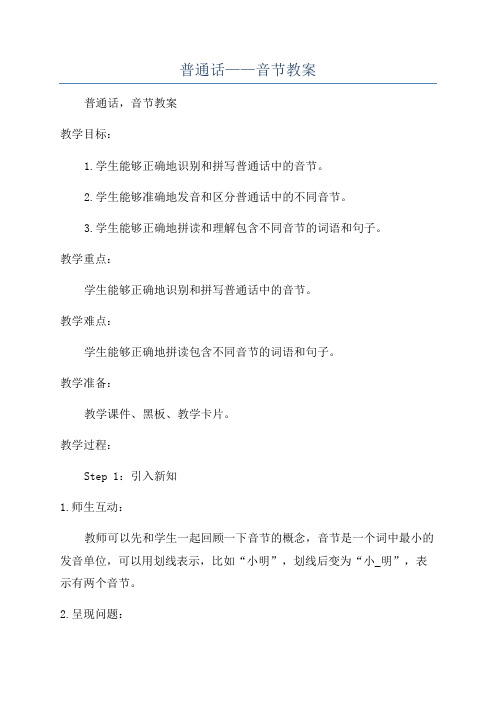
普通话——音节教案普通话,音节教案教学目标:1.学生能够正确地识别和拼写普通话中的音节。
2.学生能够准确地发音和区分普通话中的不同音节。
3.学生能够正确地拼读和理解包含不同音节的词语和句子。
教学重点:学生能够正确地识别和拼写普通话中的音节。
教学难点:学生能够正确地拼读包含不同音节的词语和句子。
教学准备:教学课件、黑板、教学卡片。
教学过程:Step 1:引入新知1.师生互动:教师可以先和学生一起回顾一下音节的概念,音节是一个词中最小的发音单位,可以用划线表示,比如“小明”,划线后变为“小_明”,表示有两个音节。
2.呈现问题:教师可以逐个展示一些词语的发音,让学生观察并判断有几个音节,比如“水果”,“苹果”,“电视”等等,然后让学生回答每个词语中有几个音节。
Step 2:讲解并鼓励学生尝试拼读1.讲解音节边界的划分:教师可以向学生解释音节边界的划分的规则,即在两个音节之间划线,比如“苹-果”,让学生理解音节的划分方式。
2.鼓励学生拼读:教师可以给学生一些拼音的音节,然后让学生尝试拼读这些音节。
比如“妈”,“爸”,“学”,“通”等等。
Step 3:辅助学生巩固1.呈现图片:教师可以呈现一些图片,并告诉学生这些图片对应的词语,然后要求学生根据所给的音节拼读这些词语。
比如,“苹果”,“桌子”,“学校”等等。
2.分组活动:教师将学生分为小组,每个小组轮流发一个音节,其他小组的成员根据所发的音节尽快拼读出一个词语并进行积分。
比如,第一个小组发出“百”,第二个小组发出“科”,第三个小组发出“技”,则其他小组要尽快拼读出“百科技”并得到积分。
Step 4:巩固和拓展训练1.听力训练:教师朗读一些包含不同音节的词语或句子,学生要仔细听,并在听完后回答相应的问题。
2.操练句子:教师给学生一些句子,学生要根据所学的音节知识将这些句子正确拼读出来,并理解其含义。
比如,“我去了一个动物园”,“他有一个好朋友”。
Step 5:作业布置1.听录音并判断:布置听录音并判断的作业,学生要根据所听到的录音回答题目,判断是否有音节的变化。
英语音节划分教案资料

英语音节划分重音一、单词重音1.双音节词a) 一般在第一个音节重读。
letter, sorryb) 有 a-, be-, de-, re-, res-, in-, im-, en-, em-, es-, ex-, con-, com-, dis-, mis-, pre-, per-, pro-, trans- 等前缀的词,第二个音节是重音。
a'bout, be'lieve, ad'dress, de'cide, re'port, con'demn, res'pect, com'pare,in'form, dis'cuss, im'press, mis'take, en'force, pre'pare, em'ploy, per'mit,es'cape, pro'duce, ex'claim, trans'latec) 有 de-, in-, re-, con-, pre- 等前缀的重音与词义和词类有关, 一般名词的重音在第一个音节上,其它的词性在第二个音节上。
'record, re'cord; 'insult, in'sult; 'conduct, con'duct; 'present pre'sent;'content, con'tentd) 有些复合词和带有前缀 re-, ex-, un-, pre-, post-, 等的词,有两个重音。
'out'side, 're'tell, 'well-'known, 'un'real, 'fif'teen, 'Chi'nese, 'pre-'war, 'post-'war2.多音节词a) 一般倒数第三个音节是重音。
《音节划分口诀》课件

“街jiē”等部分三拼音节中 ,中间的介母应和前面的元音
一起构成一个音节。
“强qiáng”等部分三拼音节 中,中间的介母应和前面的元 音一起构成一个双拼音节。
“群qún”等部分三拼音节中 ,中间的介母应和前面的元音
一起构成一个双拼音节。
03
音节划分口诀的解析
口诀的来源和意义
音节划分口诀是中国语言学中用于指导汉语音节划分的口诀,其来源可以追溯到 古代汉语的学习和教学。
音节的构成
音节通常由一个元音和若干辅音组成 ,元音是音节的核心,辅音围绕元音 构成音节。
音节的长度通常为一个或两个音素, 但也有例外,如“塞音”等。
音节的类型
开音节
半开半闭音节
以元音结尾的音节,如“he”、 “she”。
以元音和辅音组合结尾的音节,如 “have”、“make”。
闭音节
以辅音结尾的音节,如“map”、 “dog”。
音节划分的特殊规则
“给gěi”等部分三拼音节中, 中间的介母应和前面的元音一起
构成一个音节。
“行háng”等部分三拼音节中, 中间的介母应和前面的元音一起
构成一个音节。
“没méi”等部分三拼音节中, 中间的介母应和前面的元音一起
构成一个音节。
音节划分的特殊规则
01
02
03
04
“这zhèi”等部分三拼音节中 ,中间的介母应和前面的元音
02
音节划分的规则
音节划分的通用规则
音节以元音为主体,一个元音可以构成一个音节。
两个元音中间有两个辅音时,一个辅音归前一音节,一 个辅音归后一音节,例如“gē(哥)miào(庙)”。
“不、说、破、母、亲、七、也”等不能充当音节的韵 母,全部读作“u”。
初中英语音节划分教案
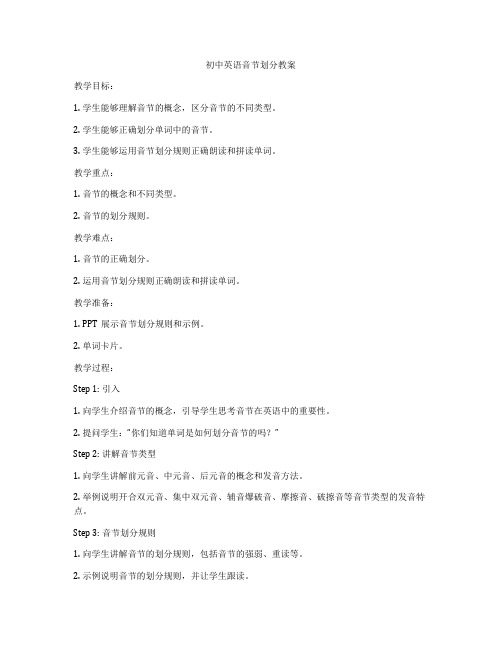
初中英语音节划分教案教学目标:1. 学生能够理解音节的概念,区分音节的不同类型。
2. 学生能够正确划分单词中的音节。
3. 学生能够运用音节划分规则正确朗读和拼读单词。
教学重点:1. 音节的概念和不同类型。
2. 音节的划分规则。
教学难点:1. 音节的正确划分。
2. 运用音节划分规则正确朗读和拼读单词。
教学准备:1. PPT展示音节划分规则和示例。
2. 单词卡片。
教学过程:Step 1: 引入1. 向学生介绍音节的概念,引导学生思考音节在英语中的重要性。
2. 提问学生:“你们知道单词是如何划分音节的吗?”Step 2: 讲解音节类型1. 向学生讲解前元音、中元音、后元音的概念和发音方法。
2. 举例说明开合双元音、集中双元音、辅音爆破音、摩擦音、破擦音等音节类型的发音特点。
Step 3: 音节划分规则1. 向学生讲解音节的划分规则,包括音节的强弱、重读等。
2. 示例说明音节的划分规则,并让学生跟读。
Step 4: 练习音节划分1. 给学生发放单词卡片,让学生尝试划分单词中的音节。
2. 引导学生注意单词中重音的位置,并正确划分音节。
Step 5: 小组活动1. 学生分组,每组选出一个单词,进行音节划分练习。
2. 每组派代表向全班展示音节划分结果,并朗读单词。
Step 6: 总结和复习1. 对学生的音节划分进行点评,指出划分错误并给予纠正。
2. 复习音节的不同类型和划分规则,让学生巩固所学知识。
Step 7: 作业布置1. 让学生回家后找一些单词,进行音节划分练习。
2. 要求学生在练习本上正确划分音节,并朗读给家长听。
教学反思:本节课通过讲解音节的概念和划分规则,让学生掌握了音节的划分方法。
通过练习和小组活动,学生能够运用音节划分规则正确朗读和拼读单词。
然而,部分学生在划分音节时仍存在困难,需要在课后加强练习。
在接下来的教学中,可以继续通过单词练习和听力训练,帮助学生提高音节划分的准确性。
汉语的音节教案
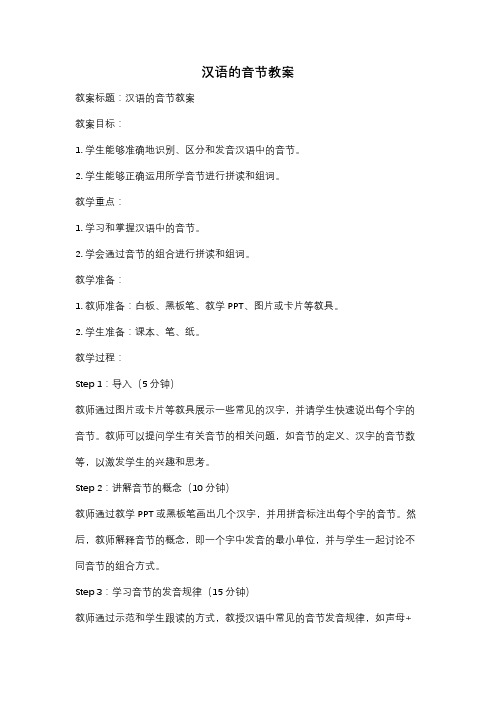
汉语的音节教案教案标题:汉语的音节教案教案目标:1. 学生能够准确地识别、区分和发音汉语中的音节。
2. 学生能够正确运用所学音节进行拼读和组词。
教学重点:1. 学习和掌握汉语中的音节。
2. 学会通过音节的组合进行拼读和组词。
教学准备:1. 教师准备:白板、黑板笔、教学PPT、图片或卡片等教具。
2. 学生准备:课本、笔、纸。
教学过程:Step 1:导入(5分钟)教师通过图片或卡片等教具展示一些常见的汉字,并请学生快速说出每个字的音节。
教师可以提问学生有关音节的相关问题,如音节的定义、汉字的音节数等,以激发学生的兴趣和思考。
Step 2:讲解音节的概念(10分钟)教师通过教学PPT或黑板笔画出几个汉字,并用拼音标注出每个字的音节。
然后,教师解释音节的概念,即一个字中发音的最小单位,并与学生一起讨论不同音节的组合方式。
Step 3:学习音节的发音规律(15分钟)教师通过示范和学生跟读的方式,教授汉语中常见的音节发音规律,如声母+韵母、单韵母、复韵母等。
教师可以用一些课堂练习来帮助学生巩固所学内容。
Step 4:练习拼读和组词(20分钟)教师提供一些音节的拼音和汉字,让学生根据所学的音节发音规律进行拼读。
然后,教师引导学生根据所给的音节组合,自己组成一些词语,并进行朗读。
教师可以设计一些游戏或小组活动来增加学生的参与度和兴趣。
Step 5:巩固与拓展(10分钟)教师总结本节课的内容,并提供一些额外的练习题供学生巩固所学知识。
教师还可以引导学生思考音节在汉语学习中的重要性,并鼓励他们在日常生活中多加练习和应用所学的音节知识。
Step 6:作业布置(5分钟)教师布置相关的作业,如完成课后练习题、编写一篇关于音节的小短文等,以巩固学生对音节的理解和应用能力。
教学反思:教师可以根据学生的实际情况和学习进度,适当调整教学步骤和方法,确保每个学生都能够有效地理解和掌握音节的相关知识。
同时,教师还可以通过多种教学手段,如游戏、小组活动等,激发学生的兴趣和积极性,提高教学效果。
初中音节划分图解教案

初中音节划分图解教案教学目标:1. 学生能够理解音节的定义和重要性。
2. 学生能够正确划分单词中的音节。
3. 学生能够运用音节划分规则进行阅读和朗读。
教学重点:1. 音节的定义和重要性。
2. 音节的划分规则。
教学准备:1. PPT或黑板。
2. 教学卡片或单词列表。
教学过程:Step 1:引入(5分钟)1. 向学生介绍音节的定义和重要性。
2. 解释音节是单词的基本发音单位,对于正确的发音和朗读非常重要。
Step 2:讲解音节划分规则(15分钟)1. 向学生讲解音节的划分规则。
2. 强调音节的划分基于单词的音素和发音。
3. 举例说明音节的划分规则,如元音字母的数量、元音字母和辅音字母的组合等。
Step 3:练习音节划分(15分钟)1. 分组学生,让他们相互练习音节划分。
2. 提供一些单词列表,让学生尝试划分每个单词的音节。
3. 鼓励学生提问并互相帮助解决问题。
Step 4:应用音节划分(10分钟)1. 让学生阅读一段文本,并尝试根据音节划分规则来朗读。
2. 提供一些句子,让学生划分句子的音节并朗读。
3. 鼓励学生注意音节的停顿和重音。
Step 5:总结和评估(5分钟)1. 让学生总结他们在本次课程中学到的音节划分规则。
2. 回答学生的问题,并解决他们的疑惑。
3. 对学生的学习情况进行评估,给予鼓励和建议。
教学延伸:1. 让学生进一步学习不同语言中的音节划分规则。
2. 让学生尝试创作诗歌或歌曲,运用音节划分规则来增加韵律感。
教学反思:本教案旨在帮助学生理解和掌握音节的划分规则,提高他们的发音和朗读能力。
通过讲解、练习和应用相结合的方式,学生可以更好地理解和运用音节划分规则。
在教学过程中,教师应注重学生的参与和互动,鼓励他们提问和互相帮助。
同时,教师应及时给予反馈和指导,确保学生能够正确地划分音节。
幼儿园大班音节分类教案

幼儿园大班音节分类教案
一、课程目标
本教案旨在通过有趣的游戏和活动,帮助幼儿园大班学生认识音节,掌握音节分类方法,提高他们的口语表达能力和听力理解能力。
二、教学步骤
1. 热身游戏
老师准备一些带有不同音节的图片,如小狗、小鸟、小鱼等,让幼儿园大班的学生先根据图片猜测这些单词的含义,并说出这些单词的音节。
2. 音节分类
老师现场口述不同音节类别的单词,如单音节、双音节和多音节单词,让学生根据听到的音节把单词分类。
老师也可以提供单词,让学生看到单词后自己归类。
3. 听音辨音
老师播放声音或读出一个单词,然后问学生包含几个音节,然后再让学生自己读出这个单词并分辨出其中的音节。
4. 游戏活动
老师设计游戏活动,如“音节拍手游戏”和“音节跳舞游戏”,让学生通过动作形式来理解音节的含义,加深印象。
三、教学重点
1.让幼儿园大班的学生能够认识音节,掌握音节分类方法。
2.提高幼儿园大班学生的口语表达能力和听力理解能力。
四、教学方法
通过热身游戏让学生预习新知识,通过听音辨音和游戏活动来加深学生的理解和记忆,让学生能够在游戏和活动中感受到学习的乐趣。
五、教学反思
本教案设计的活动和游戏均为有趣又能够理解掌握的形式,而并不是仅仅靠背诵和死记硬背。
希望能够让幼儿园大班的学生通过多种形式来感受到音节的含义,提高他们的口语表达和听力理解的能力。
音节拆解引导学生拆解音节的教案

音节拆解引导学生拆解音节的教案一、教学目标1. 理解音节的概念。
2. 能够通过拆解音节来正确发音和拼写单词。
3. 培养学生的语音意识和词汇记忆能力。
二、教学准备1. 教师准备:黑板、彩色粉笔、图片卡片、课件。
2. 学生准备:学生每人准备一本练习册。
三、教学过程步骤一:导入(5分钟)1. 教师出示图片卡片,引导学生观察卡片上的物品,并问:“你们能否告诉我卡片上的物品被分成了几个部分?”2. 学生回答后,教师解释:“对,被分成的每个部分叫做一个音节。
”步骤二:概念讲解(10分钟)1. 教师通过示意图向学生介绍音节的概念。
2. 教师解释:“一个音节通常由一个元音音素或一个元音音素和其周围的辅音音素构成。
”步骤三:音节的确定(15分钟)1. 教师出示一些单词,比如“apple”、“banana”、“elephant”等,让学生拆解这些单词的音节,并用手指敲打每个音节的次数。
2. 学生根据教师的示范,逐个拆解单词并敲打音节次数。
步骤四:练习(20分钟)1. 教师发放练习册,学生完成其中关于音节拆解的练习题。
2. 学生彼此交流答案,教师进行讲解、点评。
步骤五:拼读(15分钟)1. 教师出示一些单词卡片,学生根据拆解的音节读出单词。
2. 学生进行个人或小组练习,教师巡回辅导。
步骤六:巩固和拓展(15分钟)1. 教师出示一些音节不规则的单词,如“flower”、“table”等,引导学生探究这些单词的音节拆解规律。
2. 学生就不规则的单词进行拆解,并用手指敲打音节次数。
步骤七:总结归纳(5分钟)1. 教师和学生共同总结音节的概念和拆解方法。
2. 学生默写并背诵新学的规则。
四、教学反思通过本节课教学,学生初步理解了音节的概念及其拆解方法。
通过不断的练习,学生在音节拆解方面的能力得到了提高。
在后续的教学中,教师可以结合更多的例子和练习,进一步巩固学生对音节的掌握程度。
小学音乐音节学习教案
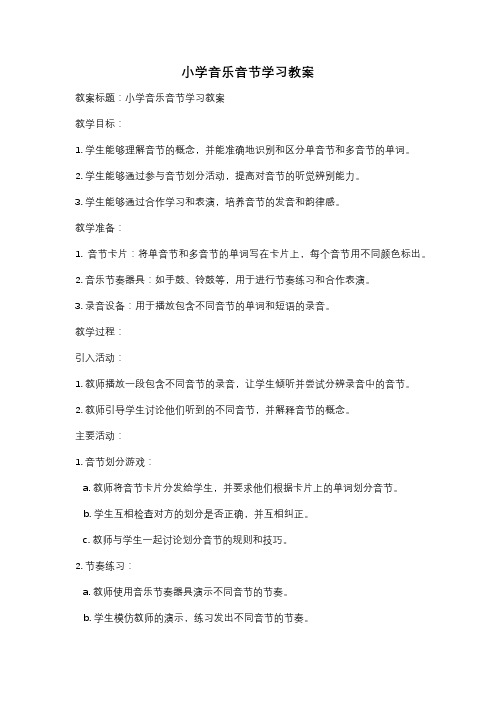
小学音乐音节学习教案教案标题:小学音乐音节学习教案教学目标:1. 学生能够理解音节的概念,并能准确地识别和区分单音节和多音节的单词。
2. 学生能够通过参与音节划分活动,提高对音节的听觉辨别能力。
3. 学生能够通过合作学习和表演,培养音节的发音和韵律感。
教学准备:1. 音节卡片:将单音节和多音节的单词写在卡片上,每个音节用不同颜色标出。
2. 音乐节奏器具:如手鼓、铃鼓等,用于进行节奏练习和合作表演。
3. 录音设备:用于播放包含不同音节的单词和短语的录音。
教学过程:引入活动:1. 教师播放一段包含不同音节的录音,让学生倾听并尝试分辨录音中的音节。
2. 教师引导学生讨论他们听到的不同音节,并解释音节的概念。
主要活动:1. 音节划分游戏:a. 教师将音节卡片分发给学生,并要求他们根据卡片上的单词划分音节。
b. 学生互相检查对方的划分是否正确,并互相纠正。
c. 教师与学生一起讨论划分音节的规则和技巧。
2. 节奏练习:a. 教师使用音乐节奏器具演示不同音节的节奏。
b. 学生模仿教师的演示,练习发出不同音节的节奏。
c. 学生分组合作,使用音乐节奏器具进行合作表演,展示他们学到的不同音节的节奏。
3. 音节表演:a. 教师指导学生选择一个单词或短语,并根据音节的特点进行表演。
b. 学生在小组内互相观摩和评价表演,提供反馈和建议。
c. 学生进行整体展示,展示他们的音节表演。
巩固活动:1. 教师播放一段包含不同音节的录音,让学生尝试辨别录音中的音节。
2. 学生互相交流他们在音节划分和表演活动中的体会和收获。
评估方式:1. 观察学生在音节划分游戏中的表现,包括准确划分音节的能力和互相纠正的合作精神。
2. 评估学生在节奏练习和合作表演中的参与度和表现水平。
3. 听取学生在巩固活动中的交流和反馈,评估他们对音节学习的理解和掌握程度。
拓展活动:1. 学生可自主选择其他单词或短语进行音节表演,展示他们的创造力和表达能力。
2. 学生可尝试编写自己的音节歌曲或韵律诗,展示他们对音节的理解和运用能力。
- 1、下载文档前请自行甄别文档内容的完整性,平台不提供额外的编辑、内容补充、找答案等附加服务。
- 2、"仅部分预览"的文档,不可在线预览部分如存在完整性等问题,可反馈申请退款(可完整预览的文档不适用该条件!)。
- 3、如文档侵犯您的权益,请联系客服反馈,我们会尽快为您处理(人工客服工作时间:9:00-18:30)。
音节划分举例划分音节举例:Basic Syllable(音节) Rules (基本音节划分原则)1. To find the number of Syllable(音节)s:---count the vowels(元音) in the word,---subtract any silent vowels(元音), (like the silent "e" at the end of a word or the second vowel when two vowels(元音) a together in a Syllable(音节))---subtract one vowel from every diphthong, (diphthongs(双元音) only count as one vowel sound.)---the number of vowels(元音) sounds left is the same as the number of Syllable (音节)s.The number of Syllable(音节)s that you hear when you pronounce a word is the same as the number of vowels(元音) sounds heard. For example:The word "came" has 2 vowels(元音), but the "e" is silent, leaving one vowel sound andone Syllable(音节).The word "outside" has 4 vowels(元音), but the "e" is silent and the "ou" is a diphthong which counts as only one sound, so this word has only two vowels(元音)sounds and therefore, two Syllable(音节)s.2. Divide between two middle consonants(辅音).Split up words that have two middle consonants(辅音). For example:hap/pen, bas/ket, let/ter, sup/per, din/ner, and Den/nis. The only exceptions are the consonant digraphs. Never split up consonant digraphs as they really represent only one sound. The exceptions are "th", "sh", "ph", "th", "ch", and "wh".3. Usually divide before a single middle consonant.When there is only one Syllable(音节), you usually divide in front of it, as in:"o/pen", "i/tem", "e/vil", and "re/port". The only exceptions are those times when the first Syllable(音节) has an obvious short sound, as in "cab/in".4. Divide before the consonant before an "-le" Syllable(音节).When you have a word that has the old-style spelling in which the "-le" sounds like "-el", divide before the consonant before the "-le". For example: "a/ble", "fum/ble", "rub/ble" "mum/ble" and "this/tle". The only exception to this are "ckle" words like "tick/le".5. Divide off any compound words(组合词), prefixes(前缀), suffixes(后缀)and roots(词根) which have vowel sounds.Split off the parts of compound words like "sports/car" and "house/boat". Divide off prefixes (前缀)such at "un/happy", "pre/paid", or "re/write". Also divide off suffixes(后缀) as in the words "farm/er", "teach/er", "hope/less" and "care/ful". In the word "stop/ping", the suffix (后缀)is actually "-ping" because this word follows the rule that when you add "-ing" to a word with one Syllable(音节), you double the last consonant and add the "-ing".怎样划分英语单词音节英语单词是由字母组成的,而字母又构成音节,音节的核心是元音,由一个或几个元音字母代表。
根据单词所含的音节,把单词分为单音节词、双音节词和多音节词。
下面给大家介绍几种如何划分音节的方法:(1)如果两个音节之间只有一个辅音字母(r除外),该字母要归右面的音节,第一音节要读作开音节。
如paper[>peip+],student[>stju:d+nt],open [>+(p+n]等。
(2)如果两音节之间有两个辅音字母(第一个不是r),这两个辅音字母分别划归左右两个音节,第一个音节为闭音节。
如:matter[>m$t+],window [>wind+u],happy[>h$pi],mid-dle[>midl]等。
注:如果两个相同的辅音字母在一起并用时,只发一个辅音字母的音,如上例。
(3)如果两音节之间有两个辅音字母,第一个是r,这两个辅音字母可分别划归左右两个音节,第一个音节按r重读音节读,如corner[>k&:Q+],certain[>s+:tn]等。
如果分界线上的两个辅音字母都是r,左边的重读音节按闭音节读。
如:car-ry[>k$ri],sorry[>s&ri],carrot [>k$r+t],borrow[>b&r+(]等。
(4)辅音字母l,m,n等也可构成非重读音节,如apple[>$pl],bottle [>b&tl],noodle[>Qu:dl],often[>&fn]等。
以上所讲正是:每个音节一元音,并连辅音两边分,还有一点需注音,字母组合不能分,缺少元音无音节,不算几个成节音。
如:([CS][AS][DS][KS][KQ][HQ][LQ])如何划分音节 Student's copy“音节划分”是拼读规则中的一个至关重要的内容,掌握它有利于拼读技能的落实。
本节将用较长的篇幅讨论。
双音节单词的音节划分方法可归纳为“两分手。
一归前或一归后”。
1.“两分手”是指:当两个元音之间有两个辅音字母时,将两个辅音字母划分在前后两个音节里。
具体细节以及读音特点,分别介绍如下:1a.当两个辅音字母相同(包括字母 r ),且重读音节在词首时:better 划分成 bet ter carry 划分成 car ryyellow 划分成 yel low borrow 划分成 bor rowmillet 划分成 mil let little 划分成 lit tle第一个音节的元音按照“短元音”读,但是相邻的那一个辅音字母没有读音。
注意:字母 l, r在非重读音节中,有时起元音的作用。
如在单词lit/tle, a/cre 中。
1b. 带前缀的单词,有时也有两个相同的辅音字母(包括字母 r ),如:attack划分成at tack arrive划分成 ar riveattend 划分成 at tend correct划分成 cor recteffect划分成 ef fect support划分成 sup port这样的单词,第一个音节是“非重读音节”,元音一般读“含糊元音”。
1c.当两个辅音字母不同(不包括字母 r )时:sister 划分成 sis ter window 划分成 win dowsystem 划分成 sys tem publish 划分成 pub lishmilky 划分成 mil ky (建议将这个单词的读音与millet 的读音相比较。
)第一个音节的元音按照“短元音”读,相邻的辅音字母有读音。
1d.当两个辅音字母不同,并且第一个辅音字母为 r 时:market 划分成 mar ket dirty 划分成 dir tycertain 划分成 cer tain forty 划分成 for tysurface 划分成 sur face purple 划分成 pur ple第一个音节的元音按照“第四类音节的读音”读。
